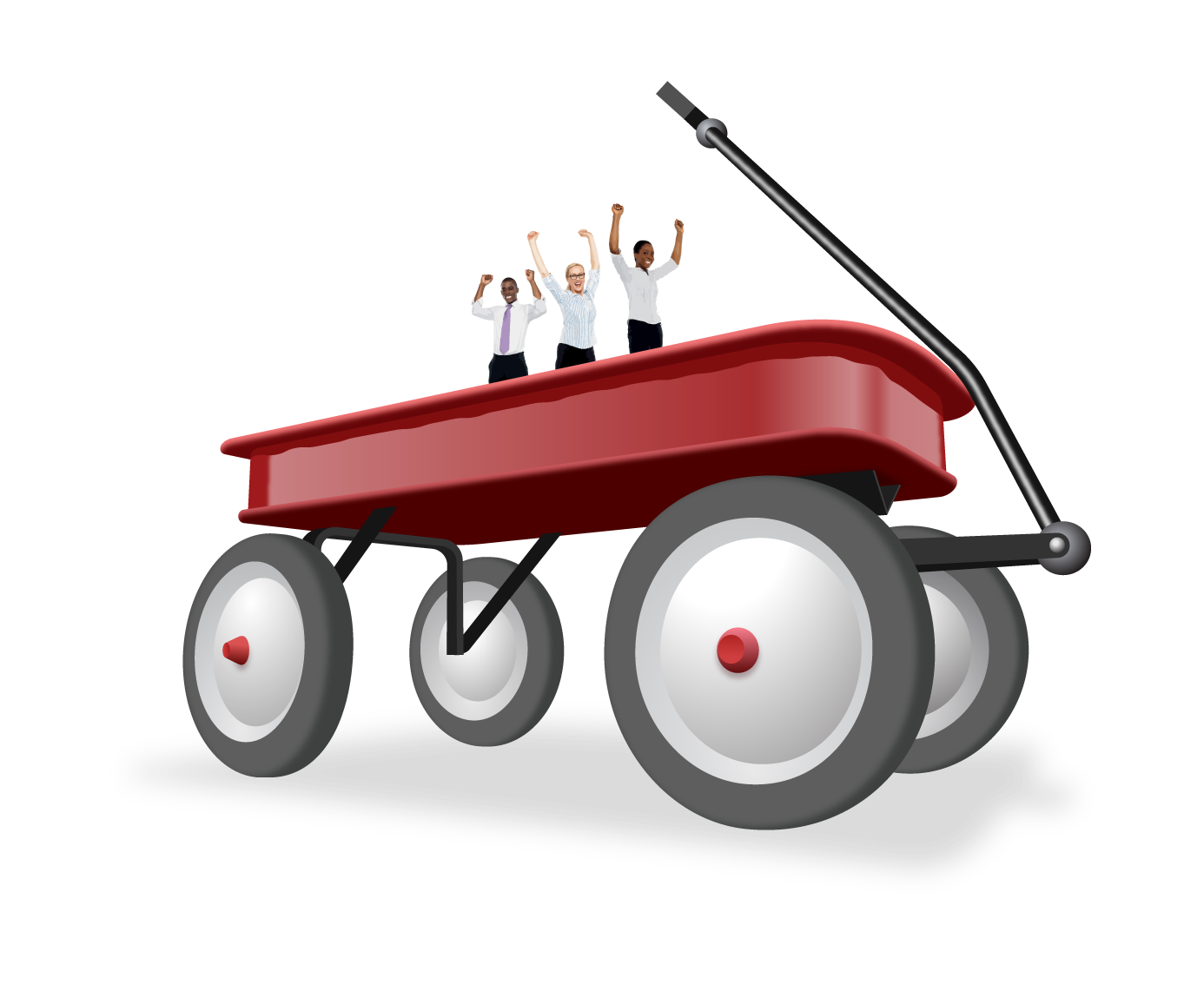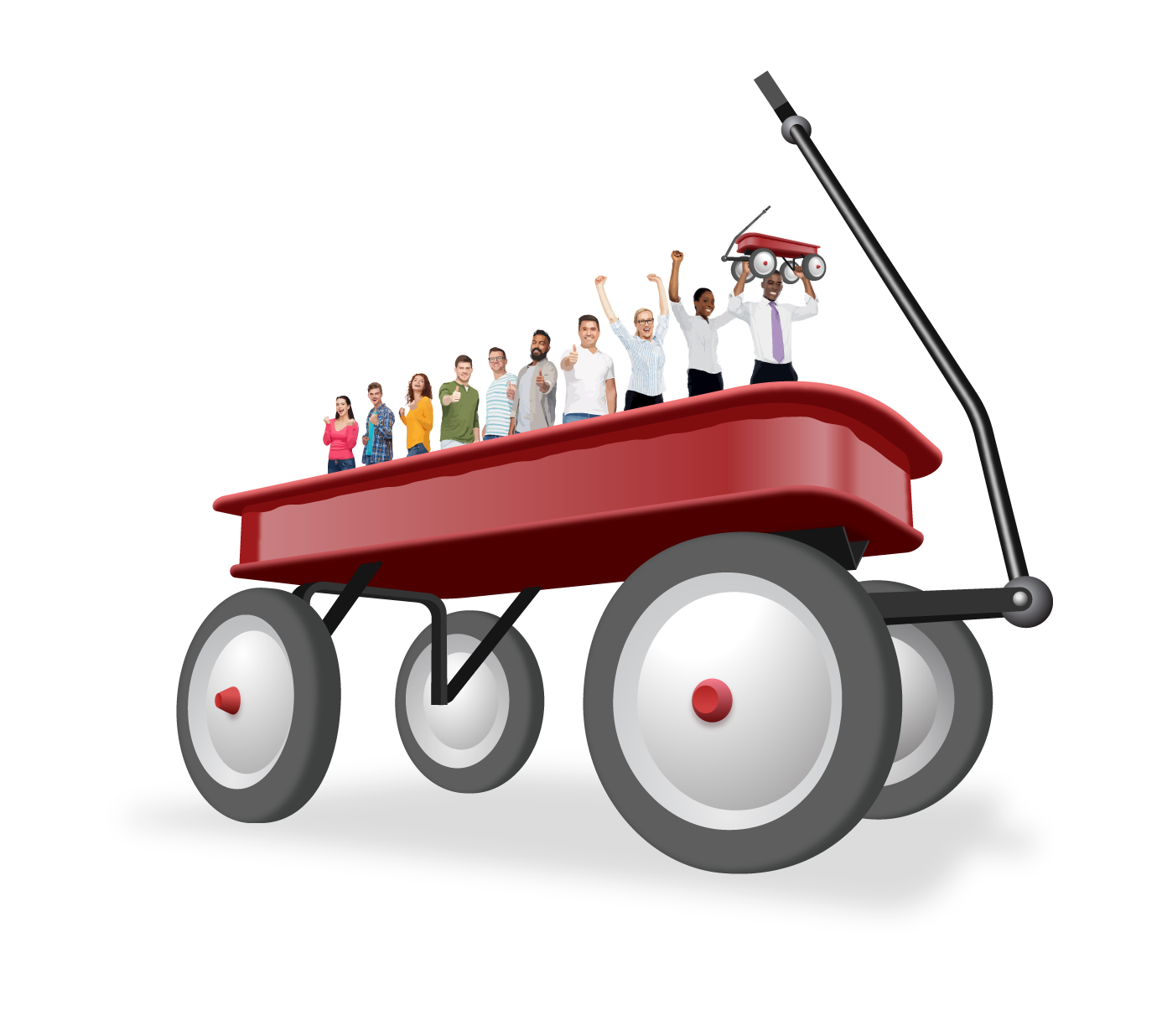Lesson 7
Estimating the Volume of the World’s Largest Wagon
Warm-up: Notice and Wonder: Radio Flyer (10 minutes)
Narrative
The purpose of this warm-up is to elicit the idea that the wagon is shaped like a rectangular prism, which will be useful when students find the volume of the wagon in a later activity. While students may notice and wonder many things about this image, the size of the wagon is the important discussion point.
Launch
- Groups of 2
- Display the image.
- “What do you notice? What do you wonder?”
- 1 minute: quiet think time
Activity
- “Discuss your thinking with your partner.”
- 1 minute: partner discussion
- Share and record responses.
Student Facing

Student Response
For access, consult one of our IM Certified Partners.
Activity Synthesis
- “What shapes do you notice in the wagon?" (The wheels are circles, the body looks like a rectangular prism or box except that the edges are curved a little bit.)
Activity 1: Anatomy of an Estimate (15 minutes)
Narrative
The purpose of this activity is for students to make a reasonable estimate for the volume of the wagon which they saw in the warm-up. Since no units are provided, students are also invited to think about which unit of measure is most appropriate for the size of the wagon. In order to compare their estimates, it is preferable if students all choose the same unit of measure, but this is not essential and it is one of the focuses of the activity synthesis. In particular there are 3 unit choices students could make:
- A small unit such as millimeters, centimeters, or inches which will require using large numbers.
- A unit that's just right, for example feet, which will yield more manageable numbers.
- A large unit, such as yards, which gives reasonable numbers to calculate but the height will likely be a fraction or decimal.
Choosing an appropriate unit of measure for an estimation and understanding how that choice affects both the calculations and the meaning of the estimate are important aspects of applying mathematics to solve real world problems (MP4).
The other focus of the activity synthesis is how to use different parts of the image to estimate the volume of the wagon. In particular, the size and number of the people in the wagon are the key points of reference in the image whose size students can reasonably estimate. Make rulers and meter or yardsticks available so that students can measure the length of their legs or the teachers' legs to help make a reasonable estimate.
Supports accessibility for: Social-Emotional Functioning
Launch
- Groups of 2
- “We are going to estimate how large the wagon is and think about how to use the image to refine our estimates.”
Activity
- 3–5 minutes: quiet work time
- 5 minutes: partner discussion time
- Monitor for students who:
- notice that the wagon has a rectangular prism shape, roughly, and recognize that we need to know the side lengths of the wagon in order to make a reasonable estimate about its volume
- use references, such as the size and number of people in the wagon, to help estimate the wagon’s volume
- choose different units of length and volume for their estimates
Student Facing
-
What measurements would you take of the wagon to accurately estimate its volume?

- What units would you use to measure the wagon? Explain your reasoning.
- Record an estimate for the volume of the wagon that is:
too low about right too high \(\phantom{\hspace{2.2cm} \\ \hspace{2.2cm}}\) \(\phantom{\hspace{2.2cm} \\ \hspace{2.2cm}}\) \(\phantom{\hspace{2.2cm} \\ \hspace{2.2cm}}\) - What can you use in the picture to refine your estimate?
Student Response
For access, consult one of our IM Certified Partners.
Activity Synthesis
- Invite students to share the measurements they would take to make an accurate estimate of the wagon’s volume.
- “Why are the length, width, and height important?” (The volume of a rectangular prism is the product of the length, width, and height.)
- Invite students to share their volume estimates, including how they chose their units and made their estimates.
- “How did you choose a unit of measure to estimate the volume?” (I wanted a longer unit because the wagon is big. Inches, centimeters, and millimeters are too small. Feet are good. Yards or meters might work too.)
- “Did anyone use millimeters or centimeters for their estimate?” (No, there would be so many millimeters and centimeters, so finding the product would be challenging and estimating the length, width and height would be hard too.)
- “Did anyone use yards or meters for their estimate?” (I tried to but I think that the height of the wagon is less than a yard or meter because the yardstick comes up way above my waist.)
- “How can you compare an estimate in cubic feet and an estimate in cubic yards?” (I can find out how many cubic feet are in a cubic yard.)
- “In the next activity you will refine your estimate, looking more carefully at the picture to make the estimate as accurate as possible.”
Activity 2: Estimating the Size of the Radio Flyer (20 minutes)
Narrative
The goal of this activity is to use multiplication and estimation to improve the estimates from the previous activity for the volume of the wagon. Students will likely count the number of people in the wagon and use this to estimate its length. They can similarly use the people in the wagon to estimate its height. Make rulers or yardsticks available in case students wish to measure how much space they take up when they stand side by side or to measure their legs or waist to estimate how high the wagon is.
While students have the tools available to work with fractional measurements, encourage them to make whole-number estimates so they can use what they learned earlier in the course about the relationship between the (whole number) measurements of a rectangular prism and its volume.
Advances: Representing, Conversing
Required Materials
Materials to Gather
Launch
- Groups of 2
Activity
- 3 minutes: individual work time
- 5 minutes: partner work time
- 5–7 minutes: gallery walk
- During the gallery walk, invite students to leave notes with questions for their classmates.
- Invite students to read the questions from their classmates and revise their estimates, if necessary.
- 1–2 minutes: independent work time
Student Facing
-
Use the picture of the wagon to make a better estimate of the length, width, and height of the wagon bed.
Make sure to:
- explain how you estimated each measurement
- include how accurate you think each estimate is

- Then improve your estimate for the volume of the wagon.
Student Response
For access, consult one of our IM Certified Partners.
Activity Synthesis
- Invite students to share their estimates.
- “Why is there a range of estimates?” (We can’t calculate any of the side lengths exactly. Our estimates for the length, width, and height of the wagon were different.)
- “What would help you make a better estimate?” (Seeing the wagon in person would let us see how high the wagon is and how the length and width compare. More photos might help.)
- “What parts of the picture were most helpful in making your estimates?” (The people, because I can estimate how tall they are and see how many of them are lined up along the side of the wagon.)
Lesson Synthesis
Lesson Synthesis
“Today we made and refined estimates for the volume of the world’s largest wagon.”
“What other question do you have about the wagon?” (Where is it located? How big are the wheels? How heavy is the handle? How many people can it hold altogether?)
“We are going to continue to investigate the wagon tomorrow.”
Cool-down: The Volume of the Wagon (5 minutes)
Cool-Down
For access, consult one of our IM Certified Partners.